The exhibition places contemporary works in direct relationship to the historic design at Chatsworth, creating unexpected connections between past and present
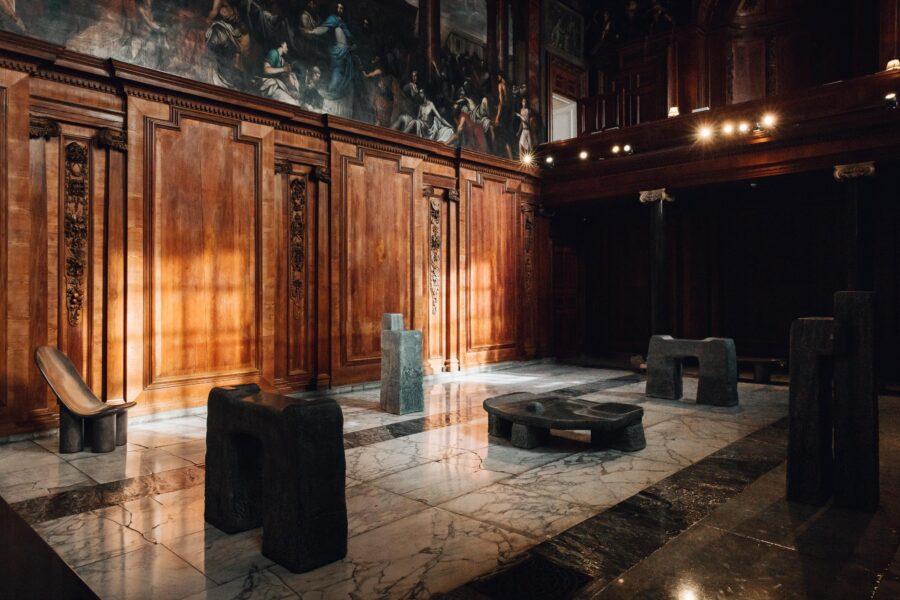 Photography by Chatsworth House Trust featuring Faye Toogood, Installation view of Mirror Mirror: Reflections on Design at Chatsworth
Photography by Chatsworth House Trust featuring Faye Toogood, Installation view of Mirror Mirror: Reflections on Design at Chatsworth
Words by Jessica-Christin Hametner
Art has been the cornerstone of Chatsworth House for 500 years. Little wonder then, that the stately home in the Derbyshire Dales is devoting a new exhibition, entitled Mirror Mirror: Reflections on Design at Chatsworth, to next-generation artists, makers and designers.
On display from 18 March to 1 October 2023, the exhibition, which is delivered in partnership with Friedman Benda gallery, and with the support of Salon 94 Design and Adrian Sassoon galleries, reflects on Chatsworth’s rich history and introduces 16 new works to the majestic house and its pristine, landscaped garden.
‘Chatsworth is run by a charity, set up in 1981, which looks after this incredible collection of art and the vast 1000-acre parkland’, says Jane Marriott, Director of Chatsworth House Trust. ‘For us, it’s important to share this and give visitors a new perspective each time they come to visit.’
 Photography by Chatsworth House Trust featuring Samuel Ross, Installation view of Mirror Mirror: Reflections on Design at Chatsworth
Photography by Chatsworth House Trust featuring Samuel Ross, Installation view of Mirror Mirror: Reflections on Design at Chatsworth
Thoughtfully co-curated by Alex Hodby, Senior Curator of Programme at Chatsworth, and writer, historian and curator Glenn Adamson, the exhibition places contemporary masterpieces in direct relationship to the historic design at Chatsworth. Exploring the bond between object and architecture, Mirror Mirror encourages visitors to reflect on the connection between the spaces we inhabit and the materials that surround us.
‘The first association of the exhibition’s title, Mirror Mirror, might be a fairy-tale, such as “Mirror, Mirror on the wall”,’ explains Adamson. ‘We were trying to capture in the title the magic of this place and how it transports you into a place of imagination. We also had in mind this idea of time travel which is really the ethos of the show,’ says Adamson.
‘Just to echo and reflect on what was said already, at Chatsworth we have an amazingly rich context in which to do anything,’ adds Hodby. ‘The collection here has such depth and breadth that we can make these incredible connections across time and across materials. But also, crucially between people.’
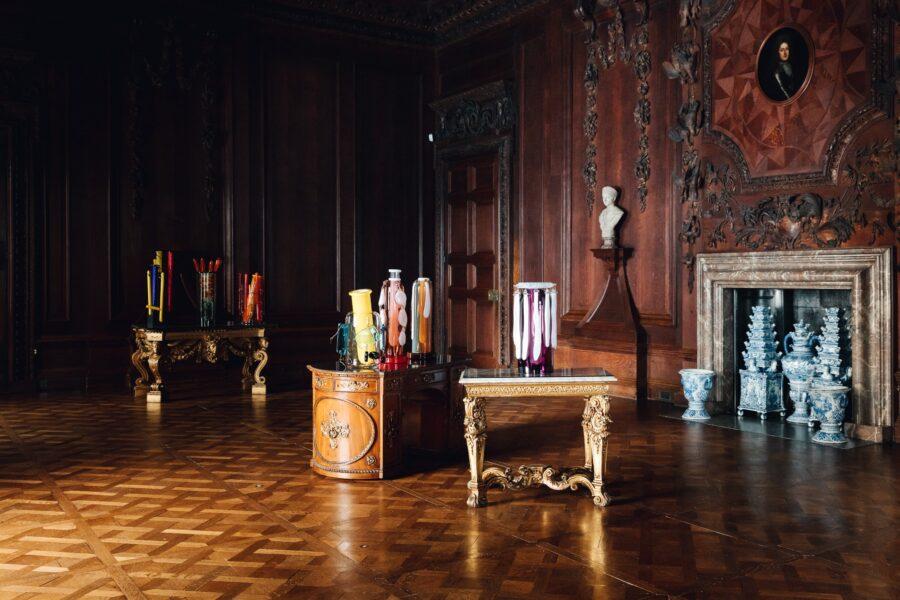 Photography by Chatsworth House Trust featuring Ettore Sottsass, Installation view of Mirror Mirror: Reflections on Design at Chatsworth
Photography by Chatsworth House Trust featuring Ettore Sottsass, Installation view of Mirror Mirror: Reflections on Design at Chatsworth
The exhibition has been expertly designed and features a group of talented artists and makers whose works grace Chatsworth’s walls and adorn display pedestals. Industrial designer Ini Archibong is showcasing his chandelier Dark Vernus I (meaning Dark Spring), which is a suspended gathering of vessel-like forms hanging in the Vestibule, while lighting luminary Michael Anastassiades, took over the Library with a sculptural installation.
Meanwhile, a trio of works by American sculptor Wendell Castle’s are gathered at the edge of a pool where his three-person seats cast in bronze stand out against the garden backdrop. Andile Dyalvane, one of South Africa’s foremost ceramic artists, has returned to the ideas he developed during a residency at Leach Pottery in St. Ives, when his vessels took on the shapes of crags overlooking the sea.
British silversmith Ndidi Ekubia, who isn’t afraid to push the craft of metal-raising to its limits, has conceived a custom suite of objects, with the graduated sizes of a garniture – a set of ceramics sometimes seen on historic mantelpieces. Their reflective surfaces play off those of two large pier glasses (mirrors supplied to Chatsworth by John Gumley in 1703), and an impressive silver chandelier in the style of Daniel Marot.
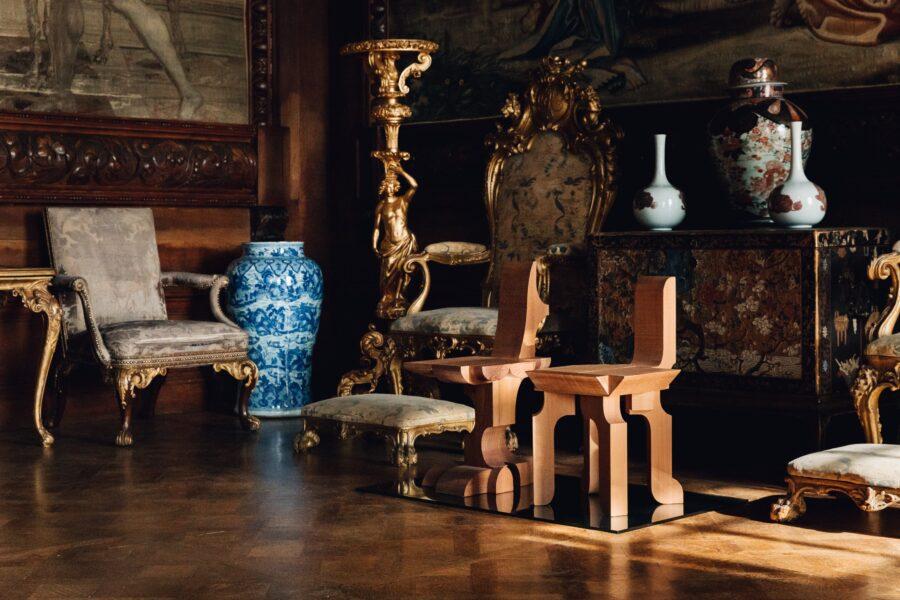 Photography by Chatsworth House Trust featuring Max Lamb, Installation view of Mirror Mirror: Reflections on Design at Chatsworth
Photography by Chatsworth House Trust featuring Max Lamb, Installation view of Mirror Mirror: Reflections on Design at Chatsworth
Elsewhere, Beirut-born, Amsterdam-based designer Najla El Zein’s Seduction, Pair 06, a seating sculpture hand-carved in Iranian red travertine that conveys the sense of two bodies conjoined, can be enjoyed in the formality of the Rose Garden, while a showcase by Formafantasma in the Green Satin Room explores the negative and positive potential of charcoal in collaboration with Swiss charcoal burner Doris Wicki.
New work for the State Drawing Room by Max Lamb is driven by research into the woodcarving in the room, and two of Joris Laarman’s Maker Benches, digitally fabricated in wood, greet visitors in the Painted Hall. Plus, artist Fernando Laposse is presenting his cabinet and armchair with long fibres of agave in the State Bedchamber, bringing a powerful animacy to the opulent surroundings.
There’s also work by South Korean born, Seattle-based designer Jay Sae Jung Oh who crafted a new piece within her long running series of furniture made by wrapping found objects with leather cord, and Samuel Ross can be found displaying his works in stone and steel at the purpose-built 19th-century Sculpture Gallery at Chatsworth.
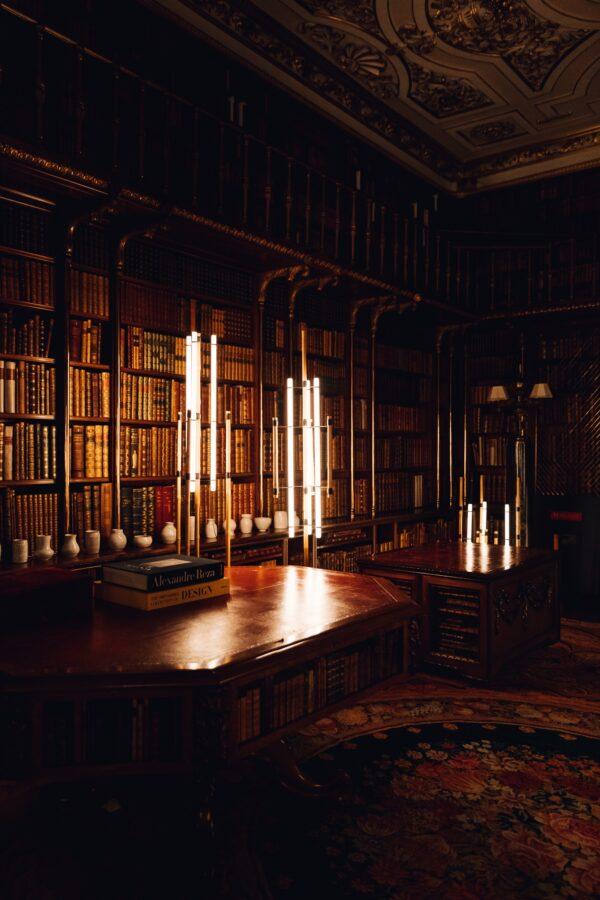 Photography by Chatsworth House Trust featuring Michael Anastassiades, Installation view of Mirror Mirror: Reflections on Design at Chatsworth
Photography by Chatsworth House Trust featuring Michael Anastassiades, Installation view of Mirror Mirror: Reflections on Design at Chatsworth
Finally, Detroit-based designer Chris Schanck who makes furniture from scraps of wood, metal, and foam, which he wraps in metallic foil and a clear coat of resin, installed two works in the Grotto, while iconic pieces by Ettore Sottsass steal the show in the Great Chamber. Faye Toogood’s installation of sculptural furniture for the Chapel in stone is a continuation of her latest collection Assemblage 7, in which the objects appear to be carefully excavated, as if by an archaeologist.
For the adjoining Oak Room, decorated in panelling bought and installed by the 6th Duke of Devonshire (1790 – 1858) in the nineteenth century, Toogood has designed a suite of objects in oak and bog oak, connecting directly with both the material of the room and its use as a gathering space. Lastly, self-taught Irish furniture maker, artist and designer Joseph Walsh displayed his pieces, largely made using steam-bent wood, in the West and South Sketch Galleries.
‘Chatsworth is a big house with a lot going on. So, we wanted to create a sense of welcome and comfort in these spaces, somewhere you’re allowed to pause, to think and to reflect,’ explains Hodby on what inspired the exhibition design. ‘That was a crucial part of the way we designed this whole experience.’
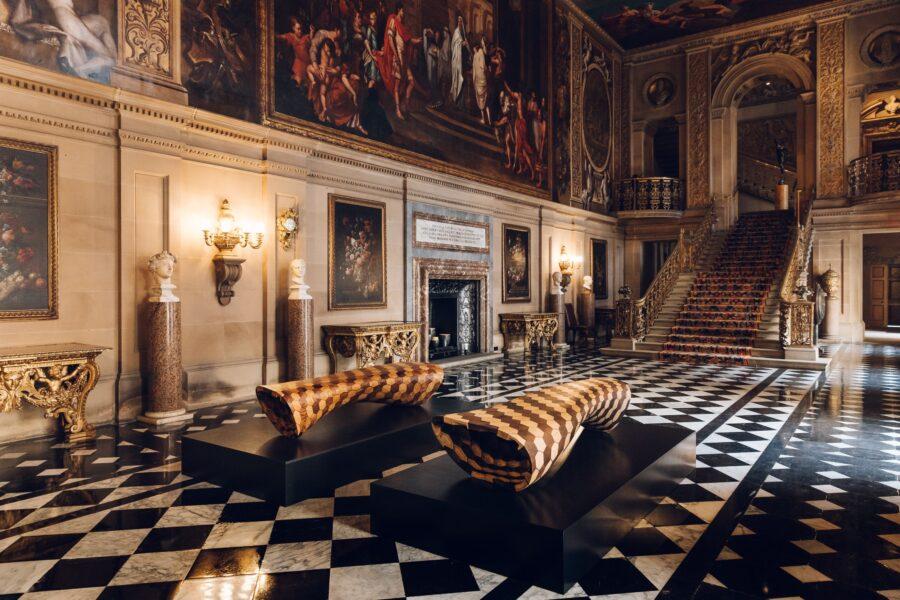 Photography by Chatsworth House Trust featuring Joris Laarman, Installation view of Mirror Mirror: Reflections on Design at Chatsworth
Photography by Chatsworth House Trust featuring Joris Laarman, Installation view of Mirror Mirror: Reflections on Design at Chatsworth
Together, Adamson and Hodby created unexpected connections with the house’s architecture, interiors and materials like glass, stone and wood. The result is a world of enchantment and magic, beautifully capturing the enduring appeal of collectible design and encouraging visitors to take a moment to pause.
‘We worked with these incredible artists and designers who inspired us to look at the house through new eyes,’ concludes Marriott. ‘This contrast between the beautiful history and new work is a very good example of how we’re hoping to encourage people to reflect. The exhibition is really a continuum of our commitment to commissioning great artists and great craftsmanship.’
Continuing its legacy into the present day, Chatsworth invites visitors to embark on a voyage through time and space. A celebration of creativity, craftsmanship and design, Mirror Mirror: Reflections on Design at Chatsworth opens up a world of imagination and an opportunity to reawaken our sense of wonder.
Mirror Mirror: Reflections on Design at Chatsworth is open now until 1 October 2023 at Chatsworth House. For more information, visit chatsworth.org
Get a curated collection of design and architecture news in your inbox by signing up to our ICON Weekly newsletter

















